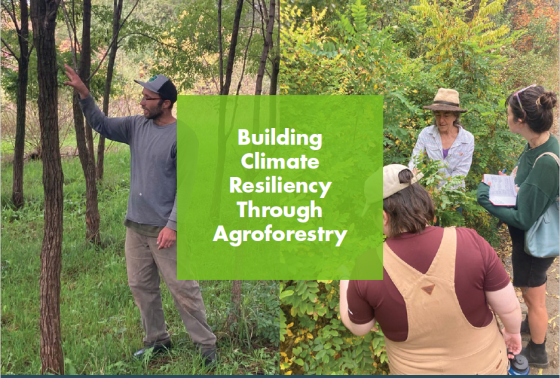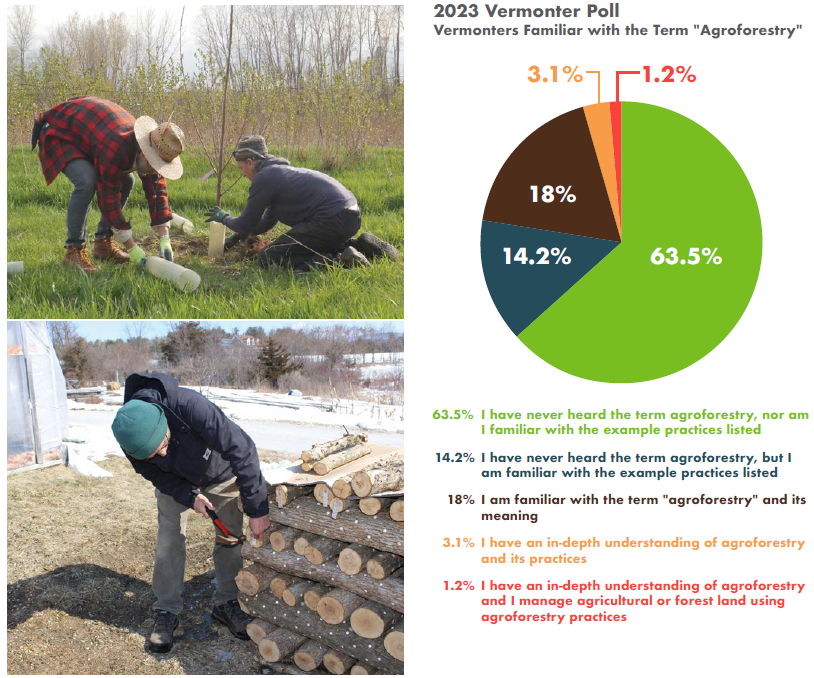Posted May 7, 2024 at 10:12am by kelly@vsjf.org
Building Climate Resiliency Through Agroforestry

Farm to Plate encourages Network members to develop new strategies that address urgent environmental issues through shared dialogue, co-learning and action. Goal category 2, “Environmental Sustainability”, provides the broader context while more specific priority strategies lay the groundwork for the expansion of innovative climate change adaptation practices.
Agroforestry is the intentional integration of trees and perennial plants into an agricultural landscape. Recognizing the need to expand innovative climate adaptation approaches, the Agroforestry Priority Strategy Team (PST) took on two projects in 2022–2023. The first was intended to expand existing knowledge of agroforestry as an important climate change mitigation strategy, and the second was focused on providing useful information to technical assistance providers, farmers, and distributors looking to put agroforestry related practices into action.
“It hasn’t been that long that trees have been removed from agricultural landscapes . . . [agroforestry] is the way that humans have grown food throughout time, up until perhaps 200 years ago. So it’s not anything new—it’s basically just a modern reinterpretation of the way that people have found of tending to a place and meeting their needs.” - Mark Krawczyk, Co-owner and Farmer, Valley Clayplain Forest Farm in New Haven, VT
Agroforestry has increasingly been seen as an important strategy for addressing climate change, expanding and diversifying farm production, and contributing to greater agricultural resiliency. While one of the smallest states, Vermont has the highest percentage of farms that are practicing agroforestry in the US. Yet there is a lack of resources available for both farmers hoping to incorporate agroforestry related practices and technical assistance providers alike. Of the resources that are available, many are regionally or even nationally focused and do not recognize both the benefits and limitations of Vermont’s specific climate zone. There are ample opportunities for expansion through education, outreach and expanded utilization of agroforestry related species. The high degree of participation in monthly meetings for this PST reflects the continued and expanding interest in this topic.
Agroforestry Storytelling and Mapping Project
This project was born out of the Agroforestry PST’s aim to enhance awareness of agroforestry by sharing the stories of agroforestry farmers in the state and showcasing the many farmers that are practicing agroforestry through an interactive story map. Farm to Plate partnered with a UVM Food Systems graduate student who completed 5 interviews with Vermont farms. Each profile provides a unique experience of the many approaches and benefits of diversifying agricultural production and landscapes. In addition, there is an online map of current agroforestry practitioners that will be updated over time.
Agroforestry Species Project
Based on feedback from the Agroforestry PST, Farm to Plate hired a consultant to create a “quick reference” list of commonly used species adaptable to the Vermont climate, and a working spreadsheet of geographically preferred agroforestry species. Starting in July 2023, information was gathered through reviewing existing resources, 10 in-depth interviews with service providers and farmers, and data gathered by 24 survey responses from growers, farmers and technical assistance providers.
The results describe the species’ potential for a wide variety of agroforestry uses and needs, considering factors such as emerging markets, function for conservation, hardiness, feed and fodder, nutrition, and cost. In response to the flooding that occurred in July 2023, flood resilient species were added as an additional important consideration. This spreadsheet will function as a “working document” that the Agroforestry PST will continue to amend and build upon as the climate continues to change and knowledge expands.
Collaborative Learning
The Agroforestry PST functions as a space for both action and co-learning with participation from farmers, technical assistance providers and researchers. This year, members of the team facilitated a session at the Farm to Plate Annual Gathering and also organized a site visit to Flag Hill Farm, a cidery featuring silvopasture and other agroforestry practices owned and operated by Sabra Ewing and Sebastian Lousada.

This story originally appeared in the 2023 Farm to Plate Annual Report.
About Vermont Farm to Plate
Farm to Plate is Vermont’s statewide food system plan implemented by 350+ member organizations of the Farm to Plate Network to meet the goals of legislation passed in 2009 calling for increased economic development and jobs in the farm and food sector and improved access to healthy local food for all Vermonters. Vermont’s farm to plate food system plan is the most comprehensive in the country and the only state that has complete government engagement. In 2019, Vermont Farm to Plate was reauthorized beyond 2020. The program is managed by the Vermont Sustainable Jobs Fund, a nonprofit organization based in Montpelier, Vermont.
